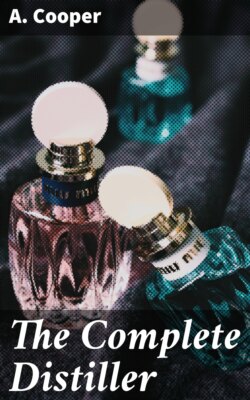Читать книгу The Complete Distiller - A. Cooper - Страница 12
На сайте Литреса книга снята с продажи.
CHAP. V.
Of Alembics, and their different Constructions.
ОглавлениеTable of Contents
Various Alembics
The Alembic is a Vessel usually of Copper tined, which serves for, and is essential to all Operations in the Distillery.
There are several Sorts of Alembics, all different, either with regard to Matter or Form. As, the common Alembic with a Refrigeratory, the earthen and the glass Alembic, the Balneum Mariæ, and the Vapour-Bath Alembic.
Every one of these being of a different Construction, are also used in different Operations.
The common Alembic consists principally of two Parts, the lower Part called the Body, and the upper termed the Head.
The Body consists of two Pieces, the lower called the Cucurbit, and the upper the Crown. The Cucurbit or lower Part of the Body, is a kind of Receptacle proportioned to the Size of the Alembic, in which the Bodies to be distilled are placed.
The Crown, or upper Part of the Body, is also another Part of the Alembic; and is that Part of the Body to which the Head is immediately luted. But an Idea of these several Alembics will be much better attained from the following Figures, which represent them much stronger to the Imagination than is possible to be done by Words.
Fig. 1. Is a common Alembic, as it appears before it is placed in a Furnace, where a is the Bottom, b the Crown, c the Head.
Fig. 2. Is the Body without the Head; a the Rim or Top of the Crown where the Head is luted.
Fig. 3. The Head; a the Rim where it is to be luted to the Body; b the Nose, or End which is luted into the Worm.
Fig. 4. The Worm, as it appears when out of the Tub in which it is fixed when in use; a the End into which the Still Head is inserted, b that which conveys the Liquor into the Receiver.
Fig. 5. Two Stills at work in one Refrigeratory; a, b the two Still Heads, c, d the Bodies inclosed in the Brick-Work; e, e the two Fire-Places; f, f the two Ash-Holes; g a Common Receiver; h a Spout Receiver, called by Chemists a Separating-Glass, used in the Distillation of Herbs, in order to extract their essential Oil; i a Crane for drawing the Water out of the Refrigeratory.
Fig. 6. A small Still with a Refrigeratory; a the Body, b the Head, c the Refrigeratory filled with Water, d the Receiver, luted to the Bec of the Alembic.
Fig. 7. A Glass Alembic to be used as a Balneum Mariæ; a the Body, b the Head, c the Bec, which is to be luted to the Receiver, d a Trivet on which it is standing in the Water.
Fig. 8. A proper Receiver for the Glass Alembic, called by Chemists a Bolt-Head, or Matrass.
Fig. 9. The Glass Alembic placed in a Copper Vessel; a the Copper Vessel filled with Water, b the Body of the Glass Alembic, c the Head, d the Receiver luted at c to the Bec of the Alembic.
Fig. 10. A cold Still for distilling simple Waters; a the Head, b the Bec, or Nose, c the Receiver, d the Plate on which Herbs are laid.
Fig. 11. A Vessel for Digestion, called by Chemists a Pelican or circulatory Vessel; a the Body, b the Head, c, c two Tubes, luted at d, d, by which the Liquor returns from the Head into the Body; e a Furnace on which it is placed, f the Fire-place, g the Ash-hole.
Fig. 12. Another Receiver, used when it is necessary to lute it to the End of the Worm, in order to prevent the most volatile Parts from being evaporated, and lost.
